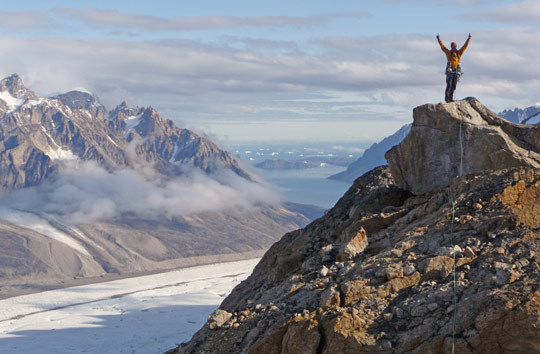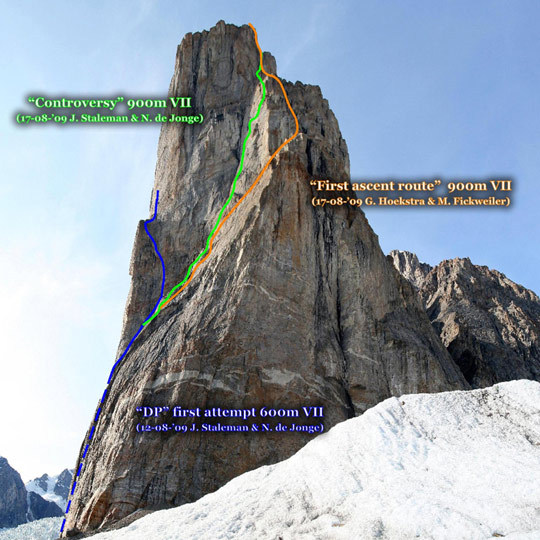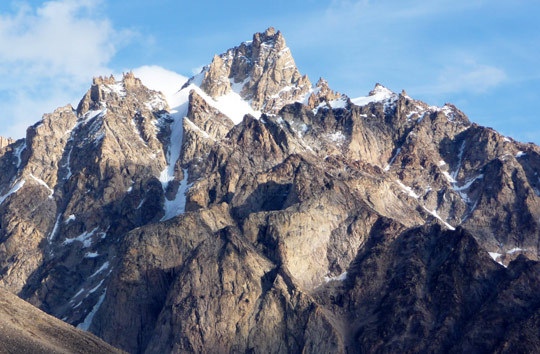
Gerke Hoekstra atop The Cenotaph, Ren Land, Greenland, having made the formation’s First Ascent Route (VII [5.10d], 900m). Hoekstra, Martin Fickweiler, Niek de Jonge and Jelle Staleman spent three weeks in Ren Land in August. They believe they are the first rock climbers to visit these peaks. [Photo] Martin Fickweiler
This August, four Dutch climbers established basecamp on the Ren Land peninsula of Greenland with hopes of climbing new routes, particularly an alpine-style ascent of The Cenotaph and a big-wall ascent of Shark Tooth, both unclimbed. Though impassable rivers kept them from Shark Tooth, the team established numerous lines throughout the region and nabbed what they believe to be three virgin summits: The Cenotaph, McDonnell Peak and Small Lion.
Ren Land is located on Greenland’s east coast just north of Milne Land island. The 2008 American Alpine Journal that documented Dick Griffiths’ 2007 expedition to Ren Land–which resulted in 32 mountaineering ascents of unclimbed peaks–inspired the Dutch group to explore the same massive walls two years later. They believe they are the first rock climbers to visit the area.
Martin Fickweiler, Gerke Hoekstra, Niek de Jonge and Jelle Staleman spent more than three weeks in Ren Land and based their operations at the end of Skillebugt Inlet, in the peninsula’s southeastern region.

The Cenotaph, with Dutch routes marked. [Photo] Niek de Jonge
Seeking to dispatch the “Trango-like mountain” they had seen in the 2008 Journal right away, de Jonge and Staleman paired up and walked 10 miles over the Apusinikajik glacier to the base of The Cenotaph, a 900-meter pillar of rotten gneiss. They started up a new line on August 12, knowing they might have to aid through a blank section about two-thirds up, above an obvious spire feature. But after free climbing for nearly 2,000′, they realized the blank section “was impassable without drilling an exceptional amount of bolts or rivets,” Fickweiler wrote in a trip report. Instead of marring the face, they retreated back down loose, dangerous ground the next day and named their attempt Disappointment Pleasure (VII [5.10d], 600m).
Meanwhile, Hoekstra and Fickweiler were discovering that high water would keep them from an attempt on Shark Tooth. They decided to scout new terrain above Disappointment Pleasure. After five pitches they installed a rappel station to ensure a safer descent and continued up another four ropelengths.
In a push on August 17, both pairs completed new routes to the top of The Cenotaph. Both routes followed familiar ground then continued up new terrain for the peak’s first ascent. Fickweiler and Hoekstra followed an obvious weakness to establish First Ascent Route (VII [5.10d], 900m). De Jonge and Staleman took a more direct line, Controversy (VII [5.10d], 900m), which intersected with the other team’s route up high.

Gerke Hoekstra climbs rotten rock on The Cenotaph. [Photo] Martin Fickweiler
They also made ascents of two other previously unclimbed summits. Staleman and de Jonge climbed McDonnell Peak (ca. 2000m) on August 25 and named it after Gerard McDonnell, the climber who died tragically on K2 last year. The route began with easy scrambling that led to 50-degree mixed climbing and ultimately a 200-meter rock headwall with difficulties ranging from 6a (5.10b) to 6b+ (5.11a). Three days later, Fickweiler and Hoekstra simulclimbed The Small Lion (IV [5.5], 450m) to make the first ascent of a 1000-meter peak near basecamp.
Though pleased with what the team accomplished, Fickweiler was disappointed with the rock quality and inaccessibility of Shark Tooth. “Most of the rock quality we encountered was quite bad, not so good for rock climbing,” he said. “Maybe [the rock quality of] Shark Tooth is good, but you would need a helicopter drop-off (or a bridge) to get there. The expedition was more of a disappointment than something special. I would have liked to put up a new big-wall route. But the fact that we had a really good time with the four of us and that we climbed three virgin summits still made the expedition a success.”
The four returned home on August 30.

McDonnell Peak (ca. 2000m), first climbed by Staleman and de Jonge on August 25. [Photo] Martin Fickweiler